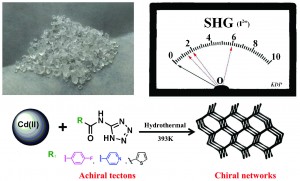Posted on behalf of Gwenda Kyd, web writer for CrystEngComm
Non-linear optical (NLO) materials are in demand due to their potential applications in photonic technologies such as laser frequency conversion and signal communication. Chiral coordination networks are likely to have good NLO properties but their formation from achiral building blocks (tectons) can be difficult.
A new paper presents a systematic study of Cd-complexes containing a range of related tetrazolate tectons, with different substituents, allowing the importance of steric and electronic factors to be considered. One molecular structure and three framework structures were formed. The size of the substituent is significant here, with smaller substituents favouring the formation of network structures. In these network structures, which crystallise in chiral space groups, the framework where the tecton has the strongest electron withdrawing substituent shows the highest second harmonic generation SHG efficiency. This compound is also phasematchable, a characteristic necessary for a laser frequency conversion material.
For more information see the paper at:
From achiral tetrazolate-based tectons to chiral coordination networks: effects of substituents on the structures and NLO properties
Jian-Zhen Liao, Da-Chi Chen, Fang Li, Yong Chen, Nai-Feng Zhuang, Mei-Jin Lin and Chang-Cang Huang
CrystEngComm, 2013, Advance Article
DOI: 10.1039/C3CE41037D, Paper
 Gwenda Kyd has a PhD in metallocarborane chemistry from the University of Edinburgh. Other research work includes the spectroscopic study of the structure of glasses and organometallic electron-transfer reactions and the preparation of new inorganic phosphors. Currently she works as a scientific database editor.
Gwenda Kyd has a PhD in metallocarborane chemistry from the University of Edinburgh. Other research work includes the spectroscopic study of the structure of glasses and organometallic electron-transfer reactions and the preparation of new inorganic phosphors. Currently she works as a scientific database editor.











